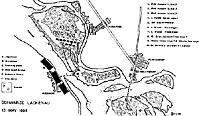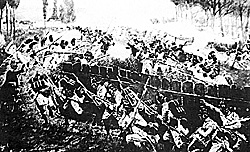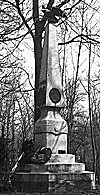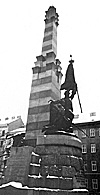On 10 April 1809 six corps of the Austrian Army launched themselves across the swollen Inn river, the border between the Habsburg Empire and France's ally Bavaria. North of the Danube another two corps debouched from Bohemia. Under the leadership of Erzherzog Karl (Archduke Charles) this bold attack was designed to catch the French and their allies unprepared, with their focus of attention drawn to the war in Spain.
The French were aware of the Austrian troop build-up. They were surprised that Austria should again be ready to return to war so soon after their humiliating capitulation at Ulm and defeat with the Russians at Austerlitz in 1805. As the Austrian army now advanced slowly into Bavaria, the thinly held front line was forced back whilst Napoleon hurried to assume command from his overstretched Chief of staff, Maréchal Berthier.

Large map (70K)
Jumbo map (243K)
For the first few days the Austrian offensive had more or less gone according to plan, hampered as it was by poor weather. On 17 April Napoleon reached the front and immediately created order where little had previously existed.
Three days later, on 20 Aril, he launched his counter-attack and at the Battle of Abensburg forced part of the Austrian forces to retreat on Landshut. Two days later the remaining section of the Austrian Army was defeated at Eggmühl (Eckmühl) but managed to retire safely to Regensburg (Ratisbonne) and cross to the north bank of the Danube.
The dispirited Austrian Army began its long retreat back to Vienna but surprisingly it was not aggressively pursued by Napoleon. In fact, the corps north of the Danube with Karl fell back largely unmolested. Those south of the Danube, led by Feldmarschalleutnant Hiller, which had retreated via Landshut, had been able to carry out a series of spirited defensive actions. Hiller finally crossed to the north bank of the Danube at Krems on 8 May. There were now no obstacles to bar Napoleon's path to Vienna.
Lannes II Corps
The first elements of the French Army, part of Lannes II Corps, reached the outskirts of the city on the morning of 10 May. As more troops arrived the garrison opened artillery fire which was returned. In the afternoon, cavalry of Massena's IV Corps swelled the numbers of the French surrounding Vienna. Napoleon himself also arrived and took up residence in Schönbrunn, the Imperial summer palace. Lannes summoned the commandant of Vienna, Archduke Maximillian d'Este, to surrender but he received no response.
Napoleon then issued a second summons and spent the morning of 11 May planning an artillery bombardment of the city. He also sent out patrols to report back on suitable places to throw bridges across the Danube. The bombardment began later that evening, a battery having been established on the Prater, an island in the river. Austrian attempts to disrupt the setting up of this battery were defeated.
During the night of 11-12 May Maximilian decided to abandon the city and withdraw to the north bank, ordering the destruction of the bridges behind him. The evacuation was completed by the evening of 12 may although many artillery pieces, stores, a treasury chest and over 2000 men were left in the city. The capitulation of Vienna followed in the early hours of 13 May.
This was a hollow victory for Napoleon. He had captured the prize of Vienna but he had not fought a decisive battle against Karl. In fact, he was no longer even sure of his whereabouts. Napoleon surmised that Karl was retreating north into Moravia and he was determined to cross the Danube at the earliest opportunity in pursuit and bring him to a final decisive battle. If Karl could get away, Napoleon would again be confronted with the long marches and exposed communications of the Austerlitz campaign of 1805. Without delay, Napoleon ordered Lannes to throw a bridge across the Danube at Nussdorf, north of Vienna.
Lannes immediately instructed St. Hilaire's 3rd Division to assemble there. Looking across the swirling, murky waters of the Danube, Lannes could see no Austrian outposts on the far bank, so he ordered a small reconnaissance party to investigate. They returned with the news that they had landed on an island that was separated from the main bank by a narrow but unfordable arm of the river. Although they had received some fire from Austrian outposts they considered the area a good staging post for the crossing. In the main, the area was a relatively flat water meadow (Au) containing a couple of buildings, a Jägerhaus (hunter's lodge) and a Wirthaus (inn).
However, perhaps the fire they had attracted had dissuaded this group from carrying out a more thorough reconnaissance. The island they had just probed was the southern end of Schwarze Lackenau. This southern section of the island was separated from the northern by a narrow water-filled ditch or channel when the river was high, but which was fordable. Beyond the channel the island was a tangle of bush and heavy undergrowth (Auwald), broken up a number of dikes, ditches and causeways, one of which connected Schwarze Lackenau with the main bank at Jedlersee. From its most northerly point to its southernmost extremity, Schwarze Lackenau was about three kilometres in length.
Preparation for a Crossing
With the reconnaissance party's positive report and an engineer's approval of the siting as the riverbank at Nussdorf commanded the opposite shore, Lannes prepared for the crossing. Lannes was determined to establish a bridgehead on Schwarze Lackenau before the Austrians realised their error in not occupying the island. He collected together all the available boats, about twenty in total, while sending off a request to Napoleon for bridging materials. To cover the crossing Lannes established two guns on the slopes above Nussdorf while the rest of St.Hilaire's artillery was placed on the road by the riverbank.
On closer inspection of the accumulated boats it was found that perhaps only seven of them were up to the task of ferrying St. Hilaire's men across the Danube. In addition, only enough experienced Pontooniers could be found to man three. The Danube at Nussdorf was about 300 metres wide and with each boat carrying about thirty men it would be a long task.
The responsibility for securing a bridgehead on Schwarze Lackenau was handed to Destabenrath's brigade of St.Hilaire's 3rd Division. This formation consisted of three battalions from each of the 72eme and 105eme de Ligne. At the outset of the campaign the 72eme had a strength of 2224 men and the 105eme had 2161. Four weeks of campaigning had reduced the 72eme to 1665 men whilst the 105eme now numbered 1463, according to figures given for 1 May 1809. The first of the three voltigeur companies of the 72eme clambered into the boats and made ready to cross to Schwarze Lackenau at about 2:00pm in preparation for the commencement of the bridging operation.
The expedition was led by Chef de Bataillon Poux of the 72eme. With the reduced strength of the regiment the total number of men that crossed must have been approximately 280. Most accounts of this action give the initial French force as close to 400 men, but this is based on the assumption that the regiment was at full strength; as demonstrated above, it was not. In order to transfer all the men across the Danube, the Pontooniers would have needed to take the three boats there and back three times.
Once landed on Schwarze Lackenau the voltigeurs were to reform at the Jägerhaus. While awaiting the arrival of his full force, Poux began to send out patrols to establish his position. On approaching the far bank of the island, where it lay close to the main bank, Austrian outposts occupying the line between Jedlersee and Florisdorf opened fire. These men were possible drawn from the 4. Viertel Unter Manhartsberg Landwehr (VUMB) and the 13. Wallach-Illyrian Grenzregiment. Colonel Vlasits of the Grenzer added the fire of some of his men positioned close to Jedlersdorf, as well as that of half a battery.
In response, the French artillery at Nussdorf began firing. Surprised by this sudden increase in fire the voltigeurs fell back on the Jägerhaus and regrouped, causing the artillery to fall silent once more. Both sides now prepared to escalate the conflict.
Send More Men
Aware of Napoleon's determination to gain a bridgehead across the Danube as quickly as possible, Lannes immediately gave orders for more men to cross to Schwarze Lackenau. When the boats were ready, Chef de Bataillon Ratteau prepared six companies of the 105eme for embarkation. These men were the voltigeur companies of the 1st and 3rd battalions as well as the grenadiers and three fusilier companies of the 2nd battalion, numbering approximately 490 men.
Colonel Csollich, a senior staff officer in Hiller's VI Korps was unsure as to whether the probe by the French was merely a reconnaissance or something more serious. He ordered a company of the 4.VUMB to cross the Staudamm (also known as the Seichtdamm), the causeway that linked Jedlersee to Schwarze Lackenau, and investigate. The landwehr advanced slowly southwards the direction of the Jägerhaus.
At about 5:00pm they made contact with the French voltigeurs of the 72eme whose numbers were now being swollen by the arrival of the first elements of the 105eme. A fierce firefight developed, and the French soon began to push the landwehr back, wading across the waistdeep channel which separated the two sections of Schwarze Lackenau in their pursuit. The sudden escalation of fire immediately alerted Colonel Csollich to the seriousness of the situation. It was imperative that he ejected the French from the island without delay, to prevent them from gaining a bridgehead on the left bank of the Danube.
Weissenwolf's brigade of VI Korps was downstream, watching the former river crossing at Gross-Jedlersdorf. Csollich ordered the three battalions of both IR4 Deutschmeister and IR49 Kerpen to march immediately to Jedlersee. They were accompanied by another two battalions, the 4. and 5. Wiener Freiwillige (Vienna Volunteers). At the same time he ordered two companies of the 13. Wallach-Illyrian Grenzregiment, temporarily detached from IV Korps, to row across to the southern tip of Schwarze Lackenau to support the planned attack. They appear, however, to have contributed little to the forthcoming action.
In the meantime, the landwehr had stubbornly continued their retirement through the thick vegetation, falling back to a long ditch that ran roughly north-west to south-east across the northern part of the island. Help was now at hand, however. Two more companies of 4.VUMB, under Major Obergfell, had advanced to support their comrades on Schwarze Lackenau and cover the advance of Weissenwolf's brigade, which had now arrived at Jedlersee.
Leaving the 5. Wiener Freiwilligen in reserve, to guard the main highway at the entrance to the village, the three battalions of the Deutschmeister moved up to line the river bank with the 4. Wiener Freiwilligen, supporting the crossing of IR49 Kerpen onto the island. Kerpen were not at full strength and probably mustered only about 1700 men.
The first battalion led the way but owing to the narrow nature of the Staudamm they were forced to cross with a three-man frontage. Once safely over the battalion's six companies reformed into three Divisions (a Division was formed by two companies). These divisions, each forming a Division Masse on a half company frontage, then advanced line abreast into the broken terrain. In simple terms the battalion advanced in three separate sections, each with a frontage of about 15 men and a depth of 12.
The first division advanced to the right with the aim of capturing the Hubertus Damm, a long dike that ran close to the western side of the island. The second division advanced through the centre while the third division, under Major O'Brien, moved to the left. When the first battalion was clear the second battalion followed and adopted a similar formation. Finally the third battalion crossed and formed two columns, each of three companies.
The first battalion of Kerpen, receiving artillery fire from Nussdorf, arrived at the ditch just as the landwehr were about to break, but they had done their job well, taking heavy casualties in the process. Although restricted by the nature of the ground, Kerpen were able to begin to put pressure on the companies of the 72eme and 105eme forcing them away from the ditch and back towards the Jägerhaus.
A group of men under Feldwebel Rentmeister from the 10th company of the second battalion, which had now joined the front line, was able to capture 40 prisoners as they fell back. The French managed to recross the channel between the two parts of the island, and re-grouped behind this new defensive barrier.
Deadlock
It was now about 7.30 p.m. and the battle appeared to be approaching deadlock. Although outnumbered, the French were well placed and it would prove costly for the Austrians to launch a frontal attack across the channel. Major O'Brien, on the left of the line, had other ideas, however. Determined to remove the French, before nightfall aided their situation, he prepared to attack. The 5th and 6th companies of the first battalion of Kerpen pushed forward over a ditch forcing the French to refuse their right a little.
Then, with about 100 men, O'Brien raced ahead, jumped into the channel close to its mouth and waded through the muddied water. Pressed heavily from the front the French were unable to halt this move which established a group of about 50 Austrians on their right flank.

The Battle of Schwarze Lackenau. This picture at right shows the point in the battle when Major O'Brien of IR49 Kerpen stormed across the channel that separated the two islands of Schwarze Lackenau. Using the protection of a wooden fence about fifty of O'Brien's men worked their way into the rear of the French. Surrounded by Austrians on three sides the French position became hopeless and only a few made good their escape. (R. Baulesch)
O'Brien was not yet finished, however. Taking the other 50 men, he pushed on, protected by a wooden fence, into a wood at the rear of the French line. The French were now in an impossible situation, attacked from the front, the rear and their flank. Chef de Bataillon Poux gathered about 100 men about him and attempted to negotiate a surrender but O'Brien refused and after a brief struggle they were taken prisoner. More Austrians crossed the channel and soon escape by boat became impossible.
The Jägerhaus formed the focus of resistance for the French, those able to reach it barricading themselves inside. Those left outside were quickly forced to surrender. O'Brien, who had provided the key to victory, now led the storming party which successfully captured the Jägerhaus. The honour of ending the very last French resistance went to Unterleutnant Zeitlinger who took the surrender of those defending the attic. By 8.00p.m. the battle was over.
The French had suffered badly. Their strength on the island had been about 770 men, but as is usual in this period it is difficult to be precise about their casualties and losses. It is probable that their total losses were at least 700, a large number being taken prisoner. Austrian casualties are more precise. IR49 Kerpen lost 12 killed and 278 wounded, while the 4. Viertel Unter Manhartsberg Landwehr had 18 killed, 93 wounded and 10 taken prisoner. Only three companies of Landwehr were reported to have been directly involved in the fighting on Schwarze Lackenau as the other three companies were lining the riverbank. These losses would certainly appear to disprove the generally perceived theory that all landwehr units were of poor quality.
After the battle the 13. Grenzregiment formed a line of outposts on the island, supported by IR4 Deutschmeister. The two Wiener Freiwillige battalions remained in Jedlersee while IR49 Kerpen withdrew to Stammersdorf. A French patrol returned to the island after dark but they were intercepted by the Deutschmeister and forded to retire. The Deutschmeister lost two men killed and five wounded; French casualties are unknown.
There were occasional alarms but the French never again attempted a river crossing at Nussdorf, although the Austrians continued to keep a very close eye on the area. In fact, they never accepted that Napoleon had entirely given up his plan to cross there, which is partly why V Korps remained in the area during the battle of Wagram eight weeks later. In the meantime, Napoleon had turned his attention downstream of Vienna.
Napoleon was determined not to lose any more time. He hastily threw a single bridge over the Danube via Lobau island into a bridgehead on the Mühlau, just to the South of the villages of Aspern and Essling. On 21 - 22 May 1809 the bloody battle of Aspern-Essling took place at which Erzherzog Karl, at the head of his regrouped Austrian Army, halted Napoleon's advance and forced the French back across the Danube. It was Napoleon's first taste of defeat.
Had Napoleon been successful at Schwarze Lackenau and forced a crossing of the Danube at Nussdorf the whole campaign could have taken a different turn. It is likely that had this been the case Karl would have retired to the North rather than standing and fighting as he did at Aspern.
In honour of his actions on Schwarze Lackenau, Major O'Brien was awarded the Maria Theresa Order and promoted to Oberstleutnant (Lieutenant-Colonel). A monument has been erected to him on Schwarze Lackenau and another can be found in Vienna, on the Gurtel close to the Westbahnhof, commemorating IR49's role in the battle. Schwarze Lackenau is no longer an island and much of it has been built over, although one section, surrounding the O'Brien monument, remains heavily wooded. Three roads in the area also remember the battle, Weissenwolfgasse, Kerpengasse and O'Briengasse. Perhaps the most fitting tribute came from Erzherzog Karl himself when he wrote, 'Without O'Brien's bravery at Schwarze Lackenau there would never have been an Aspern'.
(all figures are approximate)
The author would like to express his gratitude to Romain Baulesch of Vienna and his family, whose hospitality is never found wanting. Romain fired my enthusiasm for the subject when he took me to the site of Schwarze Lackenau for the first time.
I would also like to thank Dave Hollins who has unselfishly undertaken the painstaking task of translating accounts of the action from the German texts that have made this article possible.
Amon, Geschichte des K.K. Inf. Reg. 'Hoch-und-Deutschmeister' Nr. 4, Vienna, 1879 The monument at right to Major O'Brien as it is today on Schwarze Lackenau. Most of the area has now been built over but this portion of Auwald remains intact. However, at the time of the battle the trees were probably not so closely packed and there would have been more undergrowth. O'Brien received the Maria Theresa Order for his bravery. (Author's Photo.)
The monument at right to Major O'Brien as it is today on Schwarze Lackenau. Most of the area has now been built over but this portion of Auwald remains intact. However, at the time of the battle the trees were probably not so closely packed and there would have been more undergrowth. O'Brien received the Maria Theresa Order for his bravery. (Author's Photo.)
 The monument at right commemorating the exploits of IR49 Kerpen at the battle of Schwarze Lackenau in Vienna. (Author's Photo.)
The monument at right commemorating the exploits of IR49 Kerpen at the battle of Schwarze Lackenau in Vienna. (Author's Photo.)
Order of Battle
Austrians
Main Force:
IR49 Kerpen (3 Battalions) 1700 men
4.Viertel Unter Manhartsberg Landwehr (3 Companies) 250 men
Reserve:
(Although close to the scene of action, these men did not take part in the fighting on the island.)
IR4 Deutschmeister (3 Battalions) 1100 men
13. Wallach-Illyrian Grenzregiment (2 Companies) 210 men
4. Wiener Freiwilligen (1 Battalion) 550 men
5. Wiener Freiwilligen (1 Battalion) 550 men
French
72eme de Ligne (3 Companies) 280 men
105eme de Ligne (6 Companies) 490 men
Acknowledgements:
Bibliography:
Castle, I., Aspern & Wagram 1809, London, 1994
Hoen, M., Das Kriegsjahr 1809 in Einzeldarstellungen, Vienna, 1906
Kriegsarchiv Wien, Krieg 1809, Volume IV, Vienna, 1907-10
Rauchensteiner, M., Die Schlacht von Aspern am 21. und 22. Mai, Vienna, 1969
Wober, F.I., 1809 Schlacht bei Aspern und Essling, Vienna, 1992
Back to Age of Napoleon No. 23 Table of Contents
Back to Age of Napoleon List of Issues
Back to MagWeb Master List of Magazines
© Copyright 1997 by Partizan Press.
This article appears in MagWeb (Magazine Web) on the Internet World Wide Web.
Other military history articles and gaming articles are available at http://www.magweb.com